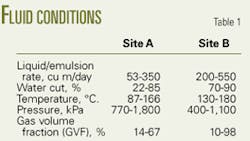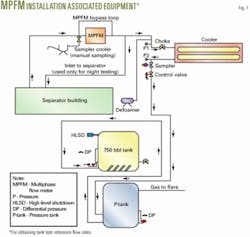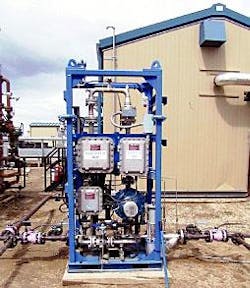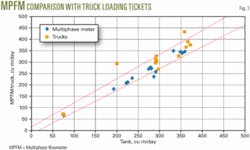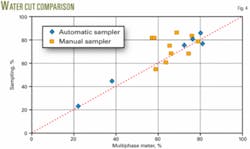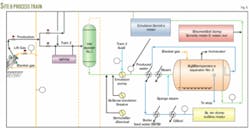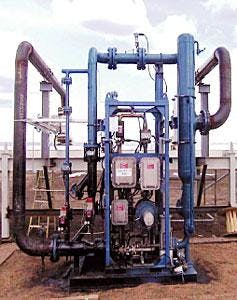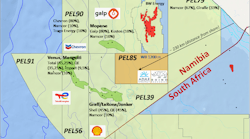Parviz Mehdizadeh
Production Technology Inc.
Scottsdale, Ariz.
Field tests in Alberta showed that multiphase meters can measure the high-temperature fluids produced in steam-assisted gravity drainage (SAGD) projects.
Two different operators conducted the tests. Both operators employ SAGD or a modification thereof to produce the bitumen, although the produced fluids differ at each of the two sites (Table 1).
Tests at both sites involved Agar Corp. manufactured multiphase meters.
The accurate measurement of oil, water, gas, and steam in heavy-oil thermal production is a difficult task, but the accuracy is critical for reservoir management and production diagnostics.
In SAGD projects, the meter has to measure a tight water and bitumen emulsion and a gas phase. The water and bitumen have similar densities, and the gas phase consists of hydrocarbons and superheated steam.
Another complication is that superheated steam can condense to water with decreases in temperature, and superheated water can flash to steam with decreases in pressure.
In a typical SAGD process, operators inject steam continuously along a horizontal well while another horizontal well below the injection well produces the mobilized bitumen and condensate steam. The typical distance between the injection and production laterals is about 5 m.
Multiphase meters
The industry has used multiphase flowmeter technology for measuring produced fluids for more than 10 years.
For instance in Venezuela’s Orinoco tar-sand belt, Petrozuata CA, a joint venture of ConocoPhillips and Petróleos de Venezuela SA (PDVSA), installed 37 multiphase meters in conjunction with multiphase pumps to replace separators, liquid pumps, and gas compressors. The multiphase technology lowered the capital expenditures for the project and has led to lower operating costs.1
Multiphase metering techniques also have yielded improved allocation factors in conventional steamflood operations.2 3
The companies that undertook the field tests described in this article were interested in assessing the capability and advantages of multiphase meters to overcome the shortcomings of the conventional gravity-based test separators commonly used in high-temperature thermal recovery operations.
The first multiphase meter tests in a SAGD project took place in fall 2004, while the second tests was completed during summer 2005.
Produced fluids
The produced fluids in Canadian heavy oil thermal wells typically have temperatures exceeding 200° C. (392° F.) with some temperatures approaching 232° C. (450° F.).
The oil-in-water emulsion produced in the SAGD process is very stable and requires chemical treatment and processing to separate the oil and water.4 Conventional gravity-based test separators used in measuring fluid rates are unable to handle this stable emulsion in the presence of steam condensate and produced gas, as well as at the high temperatures.
One example of the difficultly is a SAGD plant that processes a reverse emulsion of about 360 cu m/day (cmd) of oil and 1,200 cmd of water at 195-200° C. and 1,800 kPa (260 psig).4 At the operating temperature of the separator (about 200° C.), the produced water is less dense than bitumen. Wet oil exits from the bottom of the high-temperature separator and enters a flash treater operated at temperatures greater than 145° C. to flash out the steam.
These conditions make it difficult for conventional gravity-based test separators, with limited retention time, to produce accurate measurements of the produced fluids.
Table 1 summarizes the flow rates and fluid conditions, pertinent to production measurements, encountered in the two SAGD test sites.
Test Site A
At Site A, the field tests involved trying several different tank gauging procedures to obtain a reference flow rate to check the performance of the multiphase meter. Fig. 1 illustrates the layout for the measurement method that proved accurate enough as a reference measurement for verifying the multiphase meter performance. Table 2 summarizes these methods and Fig. 2 shows the MPFM 301-20 meter skid used in the field test.
The skid as designed can handle 600 cmd of liquid and 765 actual cmd of gas at operating temperatures as high as 232° C. Reference 5 provides a detailed description of the meter.
The process, shown in Fig. 1, cools the produced emulsion before it enters the pressure tank that acts as a separator. The process dumps the fluid into the atmospheric tank in which pressure transducers provide a measurement of the pressure head. The pressure head then is converted to a liquid volume based on the oil and water density as well as the water cut data from the manual or automatic sampling. In the last step, these measurements are converted to flow rates for verifying the volumetric readings from the multiphase meter.
Long-stroke rod pumps produce all wells at Site A. The combination of lift method, operating pressure, and temperature as well as the SAGD process at Site A produced a flow stream that has a fairly low gas (steam and hydrocarbon) volume fraction (GVF).
Subsequent performance tests of the multiphase meter against the tank data indicated that the multiphase meter accuracy is as good as the best tank test procedures and water cut sampling techniques, under practical field conditions (Figs. 3 and 4).
At Site A, the operator conducted a 12-well field-test campaign after the initial qualification tests. Fig. 5 shows the results. The multiphase meter data agree well with the tank measurements, which are the best practical reference measurements obtainable in the field.
Fig. 5 plots the results from historical well tests of these wells, obtained from conventional test separator and production measurements. For this site, the reference tank test vs. multiphase meter obtained a 0.97 allocation factor compared to the historical field data vs. tank test allocation factor of 1.40.
This improvement in allocation factor with multiphase metering is important for improving the monitoring of production processes.1-3
Test Site B
At Site B, another operator conducted a 30-day well test on two pairs of SAGD wells. Fig. 6 shows the test layout at Site B. Site B had two pairs of SAGD wells. Well 1 produced a 98% GVF stream containing saturated steam with an electrical submersible pump (ESP) for artificial lift. Well 2 produced a stream with a 30% GVF stream containing undersaturated compressed water on steam lift.
Because high GVF is one of the major parameters affecting the accuracy of measurements in the multiphase meters,6 7 an Agar 401-20-40 meter, modified to withstand high temperatures, was installed to handle the GVF range encountered at Site B (Fig. 7).
This meter skid can handle 600 cmd of liquid and 21,200 actual cmd of gas at operating temperatures up to 232° C. References 8 and 9 cover the principle of operation for this multiphase meter. The vendor also had to modify the meter software and measurement algorithm to account for steam rather than hydrocarbon as the largest component of the gas phase.
Site B did not have reference tank test data but the multiphase meter readings were compared to a Coriolis meter output that measured the emulsion flow rate at the liquid leg of the production separator and the flow rates of bitumen and water from the HTS No. 2 separator (Fig. 6).
A Coriolis meter and an inline water-cut monitoring device for the water-cut correction provided the bitumen-oil dump flow rates, and a turbine meter measured the water-dump flow rates.
These measurements have inaccuracies that introduce data uncertainty. Also the absolute accuracy of oil and water measurement from the separator dump is unavailable, and a claim for the absolute accuracy of the well rate data from multiphase meter is therefore impossible under these field conditions.
Fig. 8 compares the emulsion flow rate data from multiphase meter with the data from the production separator. Both sets of data are in close agreement.
Fig. 9 is another comparison of multiphase meter data with the HTS No. 2 separator output.
As in the tests conducted at Site A, as well as other field tests,1 2 5 10 11 one’s ability to assign an absolute accuracy level to the multiphase meter data obtained in the field is limited by the quality of the reference field data.
Fig. 9 shows that the multiphase meter test data are consistent and follow the trend of the fluid output from the separator, which is more than 50 cmd. The plot indicates some over reporting of oil and under reporting of water, especially after the shut down on May 23 for workover operations. This variance may be due to the uncertainty introduced by the reference water-cut device.
This device had shown previous discrepancies with water cut from the field production data. The deposition of heavy oil components on the probes in the multiphase meter during the shutdown of May 27-28 for a workover may have caused another error.
From the qualification tests at Site A (Figs. 3 and 4), one can reasonably assume that multiphase meter provides well flow rate data that is close to the actual values at Site B.
Results
Field verification data obtained at Sites A and B indicate that the multiphase meters used in these field tests can reliably measure the challenging fluid at the high-temperature operation and provide reliable flow rates and water-cut data.
The multiphase meters provided consistent measurements. The accuracy of the measurements matched the level of accuracy attained with very rigorous tank measurements.
In addition, the multiphase meter provided online data (Fig. 10) for production and well diagnostics.1 These tests indicate that multiphase meters are a viable and improved measurement alternative to conventional test separators for well testing under SAGD process conditions.
It should be also noted that to obtain the quality of flow rate and water-cut data from conventional measurement methods in the previous field tests, the operators had to go through considerable effort and equipment modifications as well as revisions to measurement practices (Table 2 and Fig. 1). Normally, field operations cannot afford this level of attention.
Using the multiphase meter, on the other hand, can provide the same or better quality data without the need for all the equipment modifications and extra personnel interventions required for tank testing and manual or automatic water-cut sampling. Additionally operators can access the data online, thus giving them an import diagnostic tool for monitoring SAGD production.
Acknowledgment
The author acknowledges the input and technical discussions provided by Michael Dlugan, Long Lake Project, Nexen Inc., in preparing this article. The author also acknowledges the technical support provided by personnel from Zirco and Agar Corp. during the field tests. ✦
References
1. Bertolin, L., Mehdizadeh, P., and Stobie, G., “Petrozuata-An Application of Multiphase Metering Technology,” Paper No. SPE 89870, SPE ATCE, Houston, Sept. 28-29, 2004.
2. Means, S.R., and Mehdizadeh, P., “New Technology Improves Well Testing Units,” OGJ, Oct. 30, 2000, p. 36.
3. Buell, R.S., and Turnipseed, S.P., “Application of Lean Six Sigma in Oilfield Operations,” Paper No. SPE 84434, SPE ATCE, Denver, Oct. 5-8, 2003.
4. Wang, S., et al., “Application of a Reverse-Emulsion Breaker at SAGD Pilot Plant in Northern Alberta,” Paper No. SPE 86932, International Thermal Operations and Heavy Oil Symposium, Bakersfield, Calif., Mar. 16-18, 2004.
5. Colmenares, J., et al, “Venezuelan Experience in Multiphase Pumping and Metering Technologies: Heavy Oil Field Applications-Present and Future,” Multiphase Measurement & Production Testing User Roundtable, Houston, May 3, 2000.
6. Mehdizadeh, P., and Farchy, D., “Multiphase Flowmetering Using Dissimilar Flow Sensors-Theory and Field trials Results,” Paper No. SPE 29847, SPE Middle East Oil Show, Bahrain, 1995.
7. Williamson, J., and Mehdizadeh, P., “Alaska Regulatory Guidelines for Qualification of Multiphase Metering Systems for Well Testing” Paper No. SPE 97240, SPE Western Regional Meeting, Irvine, Calif., Mar. 30-Apr. 1, 2005.
8. Tuss, B., et al, “Field Tests of the High Gas Volume Fraction Multiphase Meter,” Paper No. SPE 36594, SPE ATCE, Denver, Oct. 6-9, 1996.
9. Ngai, C.C., Brown, M.D., and Mehdizadeh, P., “Performance Test of a High Gas Volume fraction Multiphase Meter in a Producing Field,” Paper No. SPE 38784, SPE ATCE, San Antonio, Oct. 5-8, 1997.
10. Mehdizadeh, P., and Tuss, B., “Field Test of High Viscosity Multiphase Meter,” IPC 96, Calgary, June 10-12, 1996.
11. Hasebe, B., Hall, A, Smith, B., Brady, J., and Mehdizadeh, P., “Field Qualification of Four Multiphase Flowmeters on North Slope, Alaska,” Paper No. SPE 90037, SPE ATCE, Houston, Sept. 28-29, 2004.
The author
Parviz Mehdizadeh ([email protected]) is a consultant with Production Technology Inc. He previously worked for Conoco Inc. Mehdizadeh holds a BS and MS in physics and PhD in chemical engineering and materials science from the University of Oklahoma. He is a member of SPE well operations committee and is currently working with the API committee on petroleum measurements.
